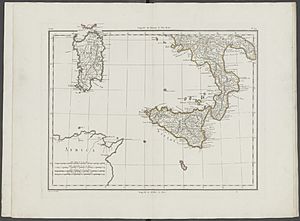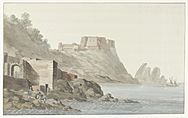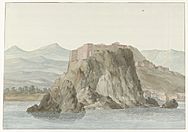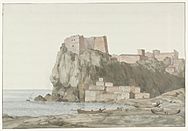Siege of Scylla facts for kids
The First Siege of Scylla was an important event that happened in Italy. It took place from July 12 to July 24, 1806. This was during a time when the British army went to Sicily to stop the French from taking over Naples.
The siege happened at Scylla Castle, located in a region called Calabria. The castle was defended by 231 French soldiers. They were from the 23rd Light Infantry Regiment. After twelve days, the French soldiers surrendered to Colonel Oswald, who led 2,600 British soldiers. His troops included soldiers from the 10th Foot, 21st Foot, and the Chasseurs Britanniques.
The British army then took control of the castle. They wanted to use it as an important base for their army in Sicily. However, the French took the castle back in a second siege in February 1808. The British soldiers had to leave by sea.
Why the Siege Happened
After a big battle called the Battle of Maida, British General Sir John Stuart returned to Monteleone. He wanted to get back the strongholds around the tip of the peninsula. The most important of these was Scylla Castle.
General Stuart sent a group of soldiers led by Colonel John Oswald to attack the castle. They also had some light cannons and two engineer officers with them. They arrived at the fort on the night of July 11. The next morning, they carefully checked out the castle.
Scylla Castle was built on top of a rock that was about 150 feet high. This rock stuck out into the sea. It was connected to the land by a narrow strip of ground. Behind the castle, the land rose to almost the same height as the rock.
The only way to attack the castle from land was from the front. This side had strong defenses with very tall walls. These walls protected the inside of the castle. There were also large, airy rooms called casemates with openings for cannons. The town of Scylla was partly on the high land behind the castle and partly on the narrow strip connecting it to the mainland.
The French soldiers defending the castle were about 400 men. They included engineers and reserve artillery. Their leader was Colonel Michel, a skilled French engineer.
The British Attack
Quick facts for kids First Siege of Scylla |
|||||||
|---|---|---|---|---|---|---|---|
| Part of the French invasion of Naples | |||||||
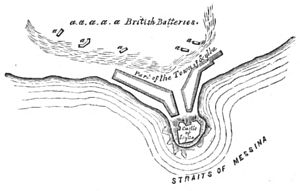 A map showing the British attack plan. |
|||||||
|
|||||||
| Belligerents | |||||||
| Commanders and leaders | |||||||
| Strength | |||||||
| 2,600 | 231 | ||||||
| Casualties and losses | |||||||
| 3 officers 35 men |
|||||||
The British decided to bring bigger cannons from Messina to break through the castle walls. At first, they only had smaller twelve-pounder field guns. They built a cannon battery for these guns and howitzers. These weapons were meant to fire into the openings of the casemates and along the castle's front.
The first battery was started on the night of July 12. But once it was ready, they realized it was too far away. So, they built a new battery about 120 yards closer and moved the cannons there.
On July 15, Captain Charles Lefebure arrived with three other officers. More engineers joined the attack. The commanding engineer approved the plans. He added a third battery for the field howitzers, even closer to the castle. From these batteries, they fired heavily almost non-stop until July 19.
On July 19, the powerful cannons needed for breaking the walls arrived from Messina. Two new batteries were quickly built for them. These were to the left of the existing batteries. Work began at nightfall on the 19th. By 11 a.m. the next day, they were ready for the cannons. The walls of these new batteries were made twenty feet thick. This fast building was possible because they had gathered many materials while waiting for the cannons.
On the morning of July 21, the cannons began firing. By the afternoon of July 22, the castle walls were badly damaged. It was clear that a large hole would soon be made. Colonel Oswald wanted to avoid a risky attack on the castle. He offered the French soldiers a chance to return to France if they left the castle.
The French accepted this offer, and they agreed to surrender. On July 23, the French soldiers handed over the fort to the British. They then sailed to France. During the few days they were under fire, they lost three officers and thirty-five men. These losses were mainly from the firing directed at the casemate openings. Captain Jones, who saw the damage, said the effects of the British fire must have been terrible for the defenders.
Lieutenant Boothby, one of the officers who arrived on July 15, stayed at the siege for only three days. On July 19, he wrote a letter from Messina. Here is part of what he said:
Our cannons had to be pulled up a very steep cliff. This made attacking the castle very hard. The soldiers only had two small cannons, which were useless after a few shots. Sir Sidney Smith managed to get two twelve-pounders and a mortar up to a spot 700 yards away. This was still too far to be very helpful. The gunboats also didn't help much. Their wild firing seemed to encourage the enemy rather than scare them.
Next, two six-pounders were brought up, but they were too light. Then, two howitzers and two twelve-pounders were ready. We quickly built a protective wall during the night, only 250 yards from the castle. This was my job, and it was quite scary. If we hadn't been completely silent, we would have lost half our group. What helped us was that the enemy was working in the castle, and we could hear every sound.
At daylight, I was happy to find myself well protected from their musket fire. They started shooting a lot from the castle for about an hour and a half. But then, Dyneley silenced them with the howitzers. He fired almost every shell exactly where it needed to go. We only had one man wounded. All yesterday, the twelve-pounders fired and destroyed a gallery. This gallery had always been full of enemy muskets, which bothered us a lot. The next step will be to bring four twenty-four-pounders within 100 yards of the castle. This will surely bring it down. The enemy commander is very active and smart in his defense. He shows he will not surrender until the wall is broken.
What Happened Next
On July 27, Sir John Stuart arrived to decide what to do with the castle. Most people thought it should be destroyed. They believed any soldiers placed there would be captured if a strong enemy attacked.
However, Captain Jones strongly disagreed. He wanted to keep the fort as an advanced base for the army in Sicily. He had noticed that the rock behind the castle, on the sea side, could not be seen from nearby land. Boats from Messina could reach within 600 to 700 yards of the fort without being seen.
So, he suggested cutting steps into the rock. This would allow the soldiers to reach the water and be taken away by boats if the fort could no longer be held. Sir John Stuart carefully checked the castle himself. He agreed with this smart idea and decided to keep the castle. Lieutenant Macleod was put in charge of this work, and it was completed successfully. At the same time, the land defenses of the castle were repaired and made stronger.
The French Attack
| Second Siege of Scylla | |||||||
|---|---|---|---|---|---|---|---|
| Part of the French invasion of Naples | |||||||
|
|||||||
| Belligerents | |||||||
| Commanders and leaders | |||||||
After capturing or defeating all French soldiers between Maida and the Straits of Messina, General Stuart was taken back to Sicily by Admiral Smith. They celebrated a successful campaign in Calabria. A small British group of soldiers was left to guard Scylla Castle. They held it until January 1808.
Then, a strong French army, led by Jean Louis Régnier, attacked them. The British defense, led by Sir Sidney Smith, continued until the front of the castle was just a pile of ruins. General Sherbrooke described the end of the siege in his report on February 23, 1808:
On the morning of February 15, Lieutenant-Colonel Robertson told me by telegraph that the castle's protective wall was destroyed. He also said all his cannons were broken or unusable. I really wanted to pull the troops out. But a strong storm kept blowing, making this impossible until the 17th.
During a short calm in the storm, we had already made all the necessary plans. The transport boats, protected by the navy's small boats, crossed over from the Faros. They successfully brought away all the soldiers. The soldiers escaped by using the sea staircase to reach the boats. While doing so, they were under heavy fire from the enemy's grape-shot and muskets. This continued until they could row out of range. I am happy to add that the loss of our troops in this dangerous situation was only four killed and five wounded. For the sailors, one was killed and ten wounded.


